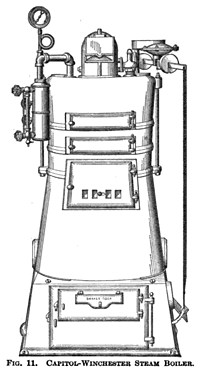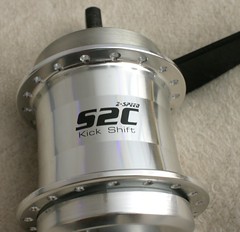On a stormy night in 1999, a MnDOT employee has pointed a traffic camera at a huge round grate in the median of Interstate 35W. Occasional cars pass by and lightning flashes. Then without warning, a geyser of water blasts high into the air. The cloud of mist obscures our view of a pickup truck crashing into the heavy steel grate, relocated to the center of the northbound lanes by the force of the water.
As round two bursts forth, a person can briefly be seen running for high ground before the mist once again obscures our view. With the protective grating now removed, getting washed "down the drain" by the receding water would certainly be a fatal trip.
The video has made the rounds on the web, and many people have seen it. I doubt many people know that this is actually right here in Minneapolis. The video is from MnDOT traffic camera #622 at Interstate 35W and 35th Street in south Minneapolis. Here's the intersection as seen from above:
View Larger Map
The grating in question caps the top of a ventilation shaft for a major storm drain tunnel that runs far beneath 35W for many miles. The tunnel serves as a main arterial route for stormwater runoff from the entire freeway to drain into the Mississippi River. The main pipe deep underground is large enough to drive a bus through. The outfall for this drain happens to be located directly beneath the 35W bridge over the river, about 3.5 miles from the location of the geyser in question.
So why does this happen? There appears to have been an engineering error somewhere along the way. As more and more feeder pipes drain into the single main pipe, it needs to get larger to accommodate the extra water. It seems that the sizing isn't quite able to keep up with a torrential downpour, and the pipe fills to the ceiling somewhere downstream from this point. The water continues to flood into the pipe further upstream, and the excess has to go somewhere. In this case, it gushes up a deep shaft and blasts into the air at 35th street. Safety concerns aside, it's quite a show.
With the recent (and ongoing) reconstruction of 35W in this area, I am not certain if the plumbing has been changed to correct this issue, or if the grating still exists as seen here.
Recreational Engineering
because DIY is serious business
Monday, September 27, 2010
35W storm drain geyser
Labels:
35W,
hydrology,
storm drains,
water
Thursday, September 23, 2010
Sturmey Archer releases new kick-shift hubs
Many people ride singlespeed bikes for commuting and day-to-day riding because there are fewer things to go wrong than with a derailleur drivetrain, and they like the simplicity. Now imagine adding a second gear and a brake to your singlespeed, but with no shift or brake cables, no derailleurs, and no exposed brake mechanism. Sound nice? What we've described is called a kickback hub, and they haven't been manufactured for many years... Until now!
In the summer of 2010, Sturmey Archer released a new internally geared hub to fill this void. It's called the S2C, and it contains mechanisms very similar to those found inside a typical three-speed hub, except that there is a special system that shifts the planetary geartrain between two different ratios every time you pedal backwards slightly. Pedal backwards a little further and with more force, and you're using the coaster brake. If you're having trouble picturing this, think of a retractable ballpoint pen. Click to extend, click to retract; It's the same idea. Some people may consider two speeds and a coaster brake a severe limitation, but anyone who has properly maintained a derailleur drivetrain through a few Minnesota winters will immediately see the possibilities.
Technical information and a video are after the jump...
In the summer of 2010, Sturmey Archer released a new internally geared hub to fill this void. It's called the S2C, and it contains mechanisms very similar to those found inside a typical three-speed hub, except that there is a special system that shifts the planetary geartrain between two different ratios every time you pedal backwards slightly. Pedal backwards a little further and with more force, and you're using the coaster brake. If you're having trouble picturing this, think of a retractable ballpoint pen. Click to extend, click to retract; It's the same idea. Some people may consider two speeds and a coaster brake a severe limitation, but anyone who has properly maintained a derailleur drivetrain through a few Minnesota winters will immediately see the possibilities.
Technical information and a video are after the jump...
Wednesday, September 22, 2010
St. Paul cathedral pipe organ tour
The cathedral in St. Paul, Minnesota is in the early stages of a major organ renovation project. James Biery, the music director at the cathedral, has created a set of YouTube videos that show the inner workings of the organs (there are actually two separate organs, as you will see) and highlights some of the problems and limitations that the renovation will address.
The videos don't get highly technical, and are actually a pretty good introduction to the basics of a pipe organ for the uninitiated. If you want to skip the somewhat pedestrian introduction and formalities and see the blower room in the basement, jump right to video #3. Check it out:
The rest of the videos are after the jump...
The videos don't get highly technical, and are actually a pretty good introduction to the basics of a pipe organ for the uninitiated. If you want to skip the somewhat pedestrian introduction and formalities and see the blower room in the basement, jump right to video #3. Check it out:
The rest of the videos are after the jump...
Labels:
cathedral,
pipe organs
Tuesday, September 21, 2010
residential boiler charts and graphs
 The duplex I live in is heated by a hot water boiler system. It's the first place I've lived since childhood with a boiler, and I was excited about it. For the uninitiated, boiler/radiator heating is very different than forced-air heat from a furnace and duct system. Air has very little thermal mass, so it heats up and cools down quickly. It also rises to the ceiling, so your head is too warm, while your feet are perpetually chilly. Radiators are made from heavy cast iron, and have a LOT of thermal mass. They take a long time to warm up, but they retain a lot of heat energy for a very long time. The biggest benefit is that the warmth from radiators is transmitted by means of radiation as well as convection into the air. Radiant heat is the same heat you can feel when the sun shines on you or you are standing near a campfire. Radiation travels in all directions through space until it is blocked by something. This means that as long as the radiator is "shining" on your body, you will be receiving warmth. Try that with forced-air, which has only become so popular because it allows for central air conditioning. But enough with theory, let's look at the equipment and then the experiment...
The duplex I live in is heated by a hot water boiler system. It's the first place I've lived since childhood with a boiler, and I was excited about it. For the uninitiated, boiler/radiator heating is very different than forced-air heat from a furnace and duct system. Air has very little thermal mass, so it heats up and cools down quickly. It also rises to the ceiling, so your head is too warm, while your feet are perpetually chilly. Radiators are made from heavy cast iron, and have a LOT of thermal mass. They take a long time to warm up, but they retain a lot of heat energy for a very long time. The biggest benefit is that the warmth from radiators is transmitted by means of radiation as well as convection into the air. Radiant heat is the same heat you can feel when the sun shines on you or you are standing near a campfire. Radiation travels in all directions through space until it is blocked by something. This means that as long as the radiator is "shining" on your body, you will be receiving warmth. Try that with forced-air, which has only become so popular because it allows for central air conditioning. But enough with theory, let's look at the equipment and then the experiment...
Labels:
boiler,
charts and graphs,
HVAC
Wednesday, September 15, 2010
Nuvinci releases improved N360 hub
 Pretty much every bicycle tinkerer out there should be vaguely familiar with the Nuvinci. While it may look like just another internally-geared bicycle hub from the outside, that's where the similarities end. Instead of sets of planetary gear trains, the Nuvinci hub contains a miniature CVT, or continuously-variable transmission. This particular flavor of CVT makes use of several balls rolling between two dish-shaped wheels. The axis of the balls can be adjusted from a shifter on the handlebars, changing the mechanical advantage of the system and creating an infinite number of "gears" within the available range of the device. Nuvinci prefers to call this system a "CVP", or continuously-variable planetary. Unlike many other CVT designs, the input and output shafts are co-axial, which means the mechanism can serve as a bicycle hub with almost no extraneous components.
Pretty much every bicycle tinkerer out there should be vaguely familiar with the Nuvinci. While it may look like just another internally-geared bicycle hub from the outside, that's where the similarities end. Instead of sets of planetary gear trains, the Nuvinci hub contains a miniature CVT, or continuously-variable transmission. This particular flavor of CVT makes use of several balls rolling between two dish-shaped wheels. The axis of the balls can be adjusted from a shifter on the handlebars, changing the mechanical advantage of the system and creating an infinite number of "gears" within the available range of the device. Nuvinci prefers to call this system a "CVP", or continuously-variable planetary. Unlike many other CVT designs, the input and output shafts are co-axial, which means the mechanism can serve as a bicycle hub with almost no extraneous components.
Labels:
bicycle,
internally geared hubs
Tuesday, September 14, 2010
An Introduction
So what exactly is recreational engineering?
Search the web for the term, and you'll find things like roller coaster inspectors, whitewater rafting park designers, and snowmobile customizers. This blog is about none of these.
In broad terms, recreational engineering is perhaps partially defined as the practical application of math and science pursued for amusement and enjoyment. This blog will serve largely as a place to journal about my projects, but you will also probably find plenty of interesting links, unusual reference material, recommended reading, and a variety of other things of interest to my target audience of like-minded individuals.
Here we go!
Search the web for the term, and you'll find things like roller coaster inspectors, whitewater rafting park designers, and snowmobile customizers. This blog is about none of these.
rec·re·a·tion
-noun
- refreshment by means of some pastime, agreeable exercise, or the like.
- a pastime, diversion, exercise, or other resource affording relaxation and enjoyment.
en·gi·neer·ing
–noun
- the art or science of making practical application of the knowledge of pure sciences, as physics or chemistry, as in the construction of engines, bridges, buildings, mines, ships, and chemical plants.
- the action, work, or profession of an engineer.
- skillful or artful contrivance; maneuvering.
In broad terms, recreational engineering is perhaps partially defined as the practical application of math and science pursued for amusement and enjoyment. This blog will serve largely as a place to journal about my projects, but you will also probably find plenty of interesting links, unusual reference material, recommended reading, and a variety of other things of interest to my target audience of like-minded individuals.
Here we go!
Subscribe to:
Posts (Atom)
